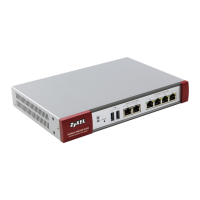Chapter 6 Configuration Basics
ZyWALL USG 20/20W User’s Guide
94
4 Auto VPN Policy: The ZyWALL automatically creates these routing entries for the
VPN rules. Disabling the IPSec VPN feature’s Use Policy Route to control
dynamic IPSec rules option moves the routes for dynamic IPSec rules up above
the policy routes (see Section 23.2 on page 394).
5 Static and Dynamic Routes: This section contains the user-configured static
routes and the dynamic routing information learned from other routers through
RIP and OSPF. See Chapter 13 on page 297 for more information.
6 Default WAN Trunk: For any traffic coming in through an internal interface, if it
does not match any of the other routing entries, the ZyWALL forwards it through
the default WAN trunk. See Section 12.2 on page 292 for how to select which
trunk the ZyWALL uses as the default.
7 Main Routing Table: The default WAN trunk is expected to be used for any traffic
that did not match any earlier routing entries.
6.4.2 NAT Table Checking Flow
The checking flow is from top to bottom. As soon as the packets match an entry in
one of the sections, the ZyWALL stops checking the packets against the NAT table
and moves on to bandwidth management.
Figure 53 NAT Table Checking Flow
1 SNAT defined in the policy routes.
2 1 to 1 SNAT (including Many 1 to 1) is also included in the NAT table.
3 NAT loopback is now included in the NAT table instead of requiring a separate
policy route.

